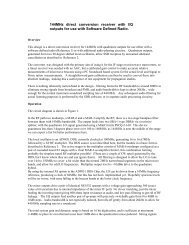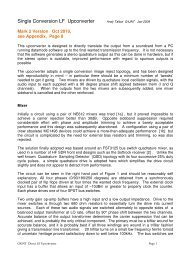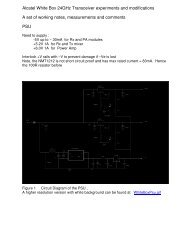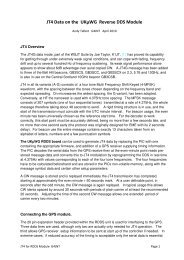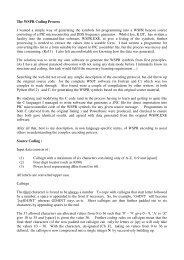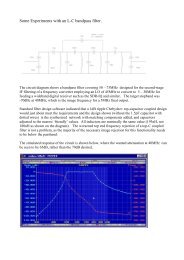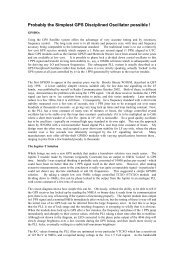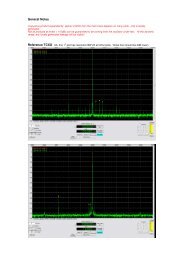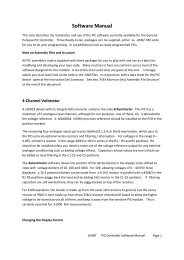LMX2541 Fractional-N Synthesizer Development PCB - G4JNT
LMX2541 Fractional-N Synthesizer Development PCB - G4JNT
LMX2541 Fractional-N Synthesizer Development PCB - G4JNT
Create successful ePaper yourself
Turn your PDF publications into a flip-book with our unique Google optimized e-Paper software.
Appendix A<br />
<strong>LMX2541</strong>CTL and <strong>LMX2541</strong>CTL_Delayed PIC Operating System<br />
A 12F629 PIC containing the <strong>LMX2541</strong>CTL code generates SPI data to allow the registers in the synthesizer<br />
chip to be set directly to the wanted values using a serial RS232, or COM Port interface with simple ASCII text<br />
commands from any terminal emulator programme such as Hyperterm. The register values can be<br />
programmed into non-volatile EEPROM memory in the PIC. At turn on, these stored values are recalled and<br />
sent to the synthesizer for immediate start up.<br />
The <strong>LMX2541</strong>CTL _Delayed version of the PIC firmware includes a three second delay after powering up<br />
before commands are sent to the synthesiser chip. This allows time for the reference input to the synth to<br />
become established. The boot up sequence involves some internal shenanigans within the chip where it uses<br />
the reference signal to for calibration of the VCO tuning range. If the reference is not present when the<br />
bootup process starts, PLL lock may not be established.<br />
Connect the RS232 lead and SPI connections as shown in Figure A1. The 4.7k resistor on the RS232<br />
interface serves to limit the current driven into the PIC input pin from the typical +/-9V of most RS232<br />
interfaces. Set the RS232 settings to 9600 baud, 8 bits, 2 stop bits, no parity, 9600-N-8-2. Flow control<br />
should be OFF. Turn on or reset the processor module, whereupon a display should appear, similar to that<br />
shown below. This shows a summary of allowed commands, followed by the stored register contents in both<br />
binary and hex that are immediately loaded into the chip. Note that characters typed are not echoed back;<br />
only responses will appear. If you want to see typed characters, set Local Echo ON in your terminal software.<br />
Registers are updated one at a time by typing R followed by eight digit hexadecimal representation of their<br />
new contents, terminated with a [cr].<br />
Example:<br />
R16880AC0[cr]<br />
(Note that the 0x shown on the response must not be typed).<br />
Followed by W [cr] to complete the actual EE write process.<br />
<strong>LMX2541</strong> CTRL<br />
Rxxxxxxx<br />
W<br />
INIT<br />
TEST<br />
0000 0000 0000 0000 0000 0000 0001 0111 0x00 00 00 17<br />
0000 0000 0000 0000 0000 0000 1100 1101 0x00 00 00 CD<br />
0000 0000 0000 0000 0000 0000 0001 1100 0x00 00 00 1C<br />
0010 1000 0000 0000 0001 0100 0000 1001 0x28 00 14 09<br />
0000 0001 0001 0001 1100 1110 0101 1000 0x01 11 CE 58<br />
0000 0000 0001 1110 0111 0010 1110 0110 0x00 1E 72 E6<br />
1010 0000 0000 0100 0000 0000 0000 0101 0xA0 04 00 05<br />
1111 1111 0100 1000 1000 0000 1010 0100 0xFF 48 80 A4<br />
0000 0000 1010 1100 0111 0011 0000 0011 0x00 AC 73 03<br />
0000 0110 0110 0010 0101 1010 0000 0010 0x06 62 5A 02<br />
0000 1001 0100 0000 0000 0000 0001 0001 0x09 40 00 11<br />
0001 0110 1000 1000 0000 1010 1100 0000 0x16 88 0A C0<br />
0001 0110 1000 1000 0000 1011 1100 0000 0x16 88 0B C0<br />
0x16 88 0B C0 Written<br />
The final LS digit of the eight defines<br />
the register address. See the data<br />
sheet for full details of register<br />
addressing. The new value is<br />
immediately transmitted to the<br />
synthesizer chip, which should<br />
respond accordingly.<br />
To save this new register value to<br />
non-volatile memory in the PIC, type<br />
W[cr] after the register contents have<br />
been accepted. A response will<br />
show that individual register has<br />
been written to EEPROM.<br />
To store multiple registers , enter<br />
these one at a time, issuing a W<br />
command for each. This is not as<br />
tedious as it sounds as subsequent<br />
updates will quite likely only require<br />
that one or two registers be altered<br />
at a time.<br />
If you get in a mess, type INIT[cr] which has the same effect as switching off and back on, reloading all the<br />
registers with the prestored values. When updating the EEPROM with several new values, it is worth issuing<br />
INIT commands periodically to check these have all been stored correctly.<br />
<strong>LMX2541</strong> <strong>Synthesizer</strong> Module <strong>G4JNT</strong> Page 8



